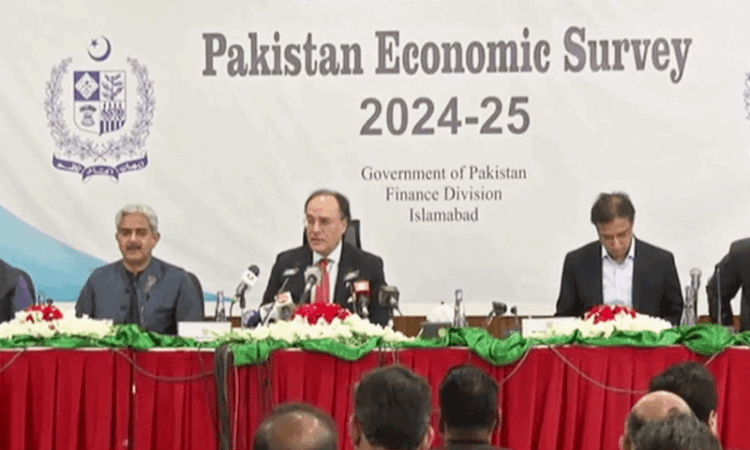Islamabad, June 9, 2025: Federal Finance Minister Muhammad Aurangzeb, while unveiling the Pakistan Economic Survey 2024-25 on Monday, announced that the country’s Gross Domestic Product (GDP) grew by 2.7% during the outgoing fiscal year, with inflation averaging a relatively modest 4.6%.
The survey, released a day ahead of the federal budget’s presentation in the National Assembly, provides a comprehensive snapshot of the country’s economic performance, including key indicators such as GDP growth, revenue collection, trade, public debt, employment, and the impact of climate change. The findings are expected to shape the national budget and future policy direction.
Key highlights:
Macroeconomic overview
The finance minister acknowledged that while the government missed its GDP growth target, several positive trends emerged, including a sharp reduction in inflation and a surge in foreign remittances. He also noted a major cut in the central bank’s policy rate—from 22% to 11%—as a response to easing price pressures.
Aurangzeb lauded record recoveries in the power sector driven by ongoing reforms. He emphasized that Pakistan’s economic recovery, though gradual, is aligning with broader global trends.
“We are now moving in a better direction and need to focus on stabilising growth,” he stated, adding that GDP is projected to reach 5.7% over the medium term.
Revenue and fiscal indicators
From July 2024 to March 2025, total revenues rose by 36.7% to Rs13,367 billion. Tax revenues grew by 26.3% to Rs9,300.2 billion, while non-tax revenues surged by 68% to Rs4,229.7 billion. The Federal Board of Revenue (FBR) met its target with a collection of Rs9,300.2 billion.
The fiscal deficit narrowed to 2.6% of GDP, and the primary surplus stood at Rs3,468.7 billion—equivalent to 3.0% of GDP.
Remittances
Remittances soared to $31.2 billion between July 2024 and April 2025—a 31% increase from $23.8 billion in the same period last year. This significant rise played a crucial role in producing a $1.9 billion current account surplus.
Inflation and monetary policy
Consumer Price Index (CPI) inflation averaged 4.7% during the first 10 months of FY2025, with April 2025 registering a record low of 0.3%. In response, the State Bank of Pakistan slashed the policy rate by 1,100 basis points over the fiscal year. The Karachi Interbank Offered Rate (KIBOR) also declined to 11.3%.
Agriculture
The agriculture sector posted a marginal growth of 0.56%. Key crops underperformed: important crops declined by 13.49%, and cotton ginning fell by 19.03%. Maize and rice yields dropped by 15.4% and 1.4%, respectively. In contrast, livestock grew by 4.72%, while other crops increased by 4.78%. Notably, potato and onion production rose by 11.5% and 15.9%.
Industrial sector
Industry grew by 4.77%, with mixed performance across subsectors. Mining and quarrying declined by 3.38%, and large-scale manufacturing contracted by 1.53%. However, electricity, gas and water supply expanded by a significant 28.88%, and construction saw 6.61% growth.
Services sector
The services sector expanded by 2.91%. While wholesale and retail trade grew by just 0.14%, transport and storage rose by 2.20%. The finance and insurance segment grew 3.22%, general government services increased by 9.92%, and other private services expanded by 3.64%.
External sector
Exports increased by 6.4% to $26.9 billion, while imports rose by 7.5% to $48.3 billion, resulting in a trade deficit of $21.3 billion. Nevertheless, the current account recorded a surplus of $1.9 billion. The exchange rate stabilised at Rs278.72 per US dollar, and foreign exchange reserves climbed to $16.64 billion.
Technology and freelancing
Aurangzeb spotlighted the growing IT sector, revealing that IT exports reached $2.8 billion, and freelancers generated $400 million during FY2025. He praised this momentum as a sign of Pakistan’s digital potential.
Tax base expansion
The number of individual tax filers doubled during the year, reflecting government efforts to broaden the tax net. The finance minister reiterated that sustained economic transformation requires two to three years and committed to further strengthening the FBR through reforms.
Social protection
The government allocated Rs471 billion to the Benazir Income Support Programme (BISP). Under this umbrella:
- Benazir Kafaalat disbursed Rs366.9 billion to 8.5 million families,
- Benazir Taleemi Wazaif provided Rs55.4 billion to 7.96 million children for education,
- Benazir Nashonuma distributed Rs5.48 billion to 0.7 million mothers and children.
Looking ahead
In closing, the finance minister commended the caretaker government for keeping the IMF programme on track and reiterated the need to reform Pakistan’s economic “DNA” for long-term stability and growth.








